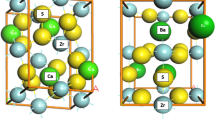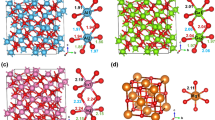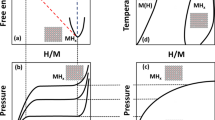Abstract
The formation energies of native point defects in crystalline α-Al2O3 were investigated by combining first principles-based methods and theoretical models in a grand canonical framework. For defect formation reactions in this framework, the chemical potentials of chemical species and electrons can be constrained by the conditions of aqueous electrochemical systems, where liquid water is thermodynamically stable. Activation relaxation technique (ART) simulations using an empirical interatomic potential were implemented to discover candidates for stable configurations of point defects. Density functional theory (DFT) calculations were then used to confirm the accurate energetics of the candidate defect configurations. The results show that, except Al vacancies, the most stable defect configurations are generated by simply adding/removing atoms at particular high-symmetry sites. We also investigated the stability of these point defects as a function of the chemical potentials of both electron and oxygen. The results reveal that, at the conditions of thermodynamic stability for liquid water in aqueous electrochemical systems, Al vacancies as the most stable point defects in α-Al2O3 can be generated in exothermic defect formation reactions with negative formation energies. These thermodynamic tendencies provide critical insights into the nature of passive films formed under aqueous electrochemical conditions, particularly explaining of the formation of amorphous structures of passive alumina.
Graphic abstract









Similar content being viewed by others
References
Kurishima K, Nabatame T, Shimizu M, Aikawa S, Tsukagoshi K, Ohi A, Chikyo T, Ogura A (2014) Influence of Al2O3 gate dielectric on transistor properties for IGZO thin film transistor. ECS Trans 61:345
Zhang C, Xie D, Xu J-L, Li X-M, Sun Y-L, Dai R-X, Li X, Zhu H-W (2015) HfO2 dielectric thickness dependence of electrical properties in graphene field effect transistors with double conductance minima. J Appl Phys 118:144301
Stournara ME, Kumar R, Qi Y, Sheldon BW (2016) Ab initio diffuse-interface model for lithiated electrode interface evolution. Phys Rev E 94:012802
Lin Y-X, Liu Z, Leung K, Chen L-Q, Lu P, Qi Y (2016) Connecting the irreversible capacity loss in Li-ion batteries with the electronic insulating properties of solid electrolyte interphase (SEI) components. J Power Sources 309:221
Li Y, Leung K, Qi Y (2016) Computational exploration of the Li-electrode| electrolyte interface in the presence of a nanometer thick solid-electrolyte interphase layer. Acc Chem Res 49:2363
Zuili D, Maurice V, Marcus P (1999) In situ scanning tunneling microscopy study of the structure of the hydroxylated anodic oxide film formed on Cr (110) single-crystal surfaces. J Phys Chem B 103:7896
Deng H, Nanjo H, Qian P, Santosa A, Ishikawa I, Kurata Y (2007) Potential dependence of surface crystal structure of iron passive films in borate buffer solution. Electrochim Acta 52:4272
Foelske A, Kunze J, Strehblow H-H (2004) Initial stages of hydroxide formation and its reduction on Co (0 0 0 1) studied by in situ STM and XPS in 0.1 M NaOH. Surf Sci 554:10
Seyeux A, Maurice V, Klein L, Marcus P (2006) In situ STM study of the effect of chloride on passive film on nickel in alkaline solution. J Electrochem Soc 153:B453
Kunze J, Maurice V, Klein LH, Strehblow H-H, Marcus P (2004) In situ STM study of the duplex passive films formed on Cu (1 1 1) and Cu (0 0 1) in 0.1 M NaOH. Corros Sci 46:245
Maurice V, Marcus P (2011) Adsorption layers and passive oxide films on metals, tribocorrosion of passive metals and coatings. Elsevier, Amsterdam, pp 29–64
Braun W, Bader M, Holub-Krappe E, Haase J, Eichinger P (1987) Structural properties of native and ultra thin thermal oxides of silicon as studied by SEXAFS. Surf Interface Anal 10:250
Seo JH, Ryu J-H, Lee DN (2003) Formation of crystallographic etch pits during AC etching of aluminum. J Electrochem Soc 150:B433
Prokes S, Katz M, Twigg M (2014) Growth of crystalline Al2O3 via thermal atomic layer deposition: nanomaterial phase stabilization. APL Mater. 2:032105
Broas M, Kanninen O, Vuorinen V, Tilli M, Paulasto-Krockel M (2017) Chemically stable atomic-layer-deposited Al2O3 films for processability. ACS Omega 2:3390
Todorova M, Neugebauer J (2014) Extending the concept of defect chemistry from semiconductor physics to electrochemistry. Phys Rev Appl 1:014001
Chagarov EA, Kummel AC (2009a) Ab initio molecular dynamics simulations of properties of a-Al 2 O 3/vacuum and a-Zr O 2/vacuum vs a-Al 2 O 3/ Ge (100)(2\(\times\) 1) and a-Zr O 2/ Ge (100)(2\(\times\) 1) interfaces. J Chem Phys 130:124717
Chagarov EA, Kummel AC (2009b) Molecular dynamics simulation comparison of atomic scale intermixing at the amorphous Al2O3/semiconductor interface for a-Al2O3/Ge, a-Al2O3/InGaAs, and a-Al2O3/InAlAs/InGaAs. Surf Sci 603:3191
Matsunaga K, Tanaka T, Yamamoto T, Ikuhara Y (2003) First-principles calculations of intrinsic defects in Al2O3. Phys Rev B 68:085110
Hine N, Frensch K, Foulkes W, Finnis M (2009) Supercell size scaling of density functional theory formation energies of charged defects. Phys Rev B 79:024112
Choi M, Janotti A, Van de Walle CG (2013) Native point defects and dangling bonds in \(\alpha\)-Al2O3. J Appl Phys 113:044501
Lei Y, Gong Y, Duan Z, Wang G (2013) Density functional calculation of activation energies for lattice and grain boundary diffusion in alumina. Phys Rev B 87:214105
Yang MY, Kamiya K, Magyari-Köpe B, Niwa M, Nishi Y, Shiraishi K (2013) Charge-dependent oxygen vacancy diffusion in Al2O3-based resistive-random-access-memories. Appl Phys Lett 103:093504
Lei Y, Wang G (2015) Linking diffusion kinetics to defect electronic structure in metal oxides: charge-dependent vacancy diffusion in alumina. Scripta Mater 101:20
French RH (1990) Electronic band structure of Al2O3, with comparison to Alon and AIN. J Am Ceram Soc 73:477
Kuznetsov A, Abramov V (1991) VV Mu rk, BP Namozov. Sov. Phys. 33:1126
Barkema G, Mousseau N (1996) Event-based relaxation of continuous disordered systems. Phys Rev Lett 77:4358
Mousseau N, Barkema G (1998) Traveling through potential energy landscapes of disordered materials: the activation–relaxation technique. Phys Rev E 57:2419
Malek R, Mousseau N (2000) Dynamics of Lennard–Jones clusters: a characterization of the activation–relaxation technique. Phys Rev E 62:7723
Cances E, Legoll F, Marinica M-C, Minoukadeh K, Willaime F (2009) Some improvements of the activation–relaxation technique method for finding transition pathways on potential energy surfaces. J Chem Phys 130:114711
Machado-Charry E, Béland LK, Caliste D, Genovese L, Deutsch T, Mousseau N, Pochet P (2011) Optimized energy landscape exploration using the ab initio based activation–relaxation technique. J Chem Phys 135:034102
Todorova M, Neugebauer J (2015a) Connecting semiconductor defect chemistry with electrochemistry: impact of the electrolyte on the formation and concentration of point defects in ZnO. Surf Sci 631:190
Todorova M, Neugebauer J (2015b) Identification of bulk oxide defects in an electrochemical environment. Faraday Discuss 180:97
Freysoldt C, Neugebauer J, Van de Walle CG (2009) Fully ab initio finite-size corrections for charged-defect supercell calculations. Phys Rev Lett 102:016402
David RL (2005) CRC handbook of chemistry and physics. CRC Press, Boca Raton
Marcus Y (1987) The thermodynamics of solvation of ions. Part 2. The enthalpy of hydration at 298.15 K. J Chem Soc Faraday Trans 83:339
Marcus Y (1991) Thermodynamics of solvation of ions. Part 5. Gibbs free energy of hydration at 298.15 K. J Chem Soc Faraday Trans 87:2995
Hölzl J, Schulte FK (1979) Work function of metals, solid surface physics. Springer, New York, pp 1–150
Kumar B, Kaushik BK, Negi Y (2014) Perspectives and challenges for organic thin film transistors: materials, devices, processes and applications. J Mater Sci 25:1
Xu S, Jacobs RM, Nguyen HM, Hao S, Mahanthappa M, Wolverton C, Morgan D (2015) Lithium transport through lithium-ion battery cathode coatings. J Mater Chem A 3:17248
Vashishta P, Kalia RK, Nakano A, Rino JP (2008) Interaction potentials for alumina and molecular dynamics simulations of amorphous and liquid alumina. J Appl Phys 103:083504
Plimpton S (1993) Fast parallel algorithms for short-range molecular dynamics, Fast parallel algorithms for short-range molecular dynamics, Tech. Rep. (Sandia National Labs., Albuquerque, NM (United States))
Perdew JP, Burke K, Ernzerhof M (1996) Generalized gradient approximation made simple. Phys Rev Lett 77:3865
Blöchl PE (1994) Projector augmented-wave method. Phys Rev B 50:17953
Kresse G, Joubert D (1999) From ultrasoft pseudopotentials to the projector augmented-wave method. Phys Rev B 59:1758
Kresse G, Hafner J (1993) Ab initio molecular dynamics for liquid metals. Phys Rev B 47:558
David LR (2003) CRC handbook of chemistry and physics, 84th edn. CRC Press, Boca Raton
Santos R, Longhinotti E, Freire V, Reimberg R, Caetano E (2015) Elucidating the high-k insulator \(\alpha\)-Al2O3 direct/indirect energy band gap type through density functional theory computations. Chem Phys Lett 637:172
Chao C, Lin L, Macdonald D (1981) A point defect model for anodic passive films I. Film growth kinetics. J Electrochem Soc 128:1187
Macdonald DD (1992) The point defect model for the passive state. J Electrochem Soc 139:3434
Acknowledgements
A. Sundar and L. Qi acknowledge support by the Mcubed Seed Funding at the University of Michigan, Ann Arbor (Project ID: 8586). This research was supported in part through computational resources and services provided by Advanced Research Computing at the University of Michigan, Ann Arbor. This work also used the Extreme Science and Engineering Discovery Environment (XSEDE) Stampede2 at the TACC through allocation TG-DMR190035.
Author information
Authors and Affiliations
Corresponding author
Additional information
Publisher's Note
Springer Nature remains neutral with regard to jurisdictional claims in published maps and institutional affiliations
Rights and permissions
About this article
Cite this article
Sundar, A., Qi, L. Stability of native point defects in α-Al2O3 under aqueous electrochemical conditions. J Appl Electrochem 51, 639–651 (2021). https://doi.org/10.1007/s10800-020-01526-w
Received:
Accepted:
Published:
Issue Date:
DOI: https://doi.org/10.1007/s10800-020-01526-w




